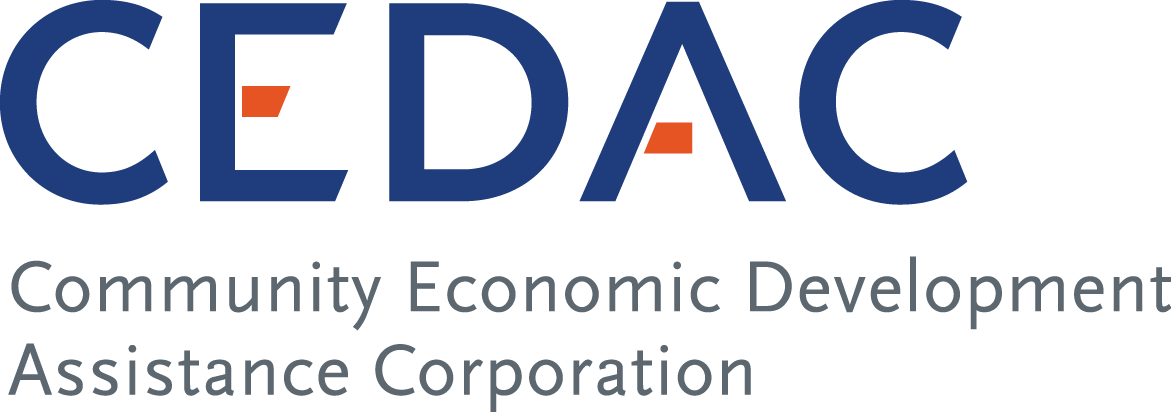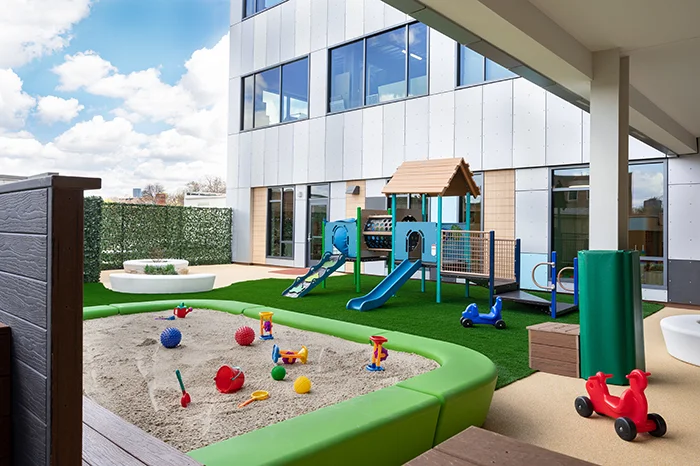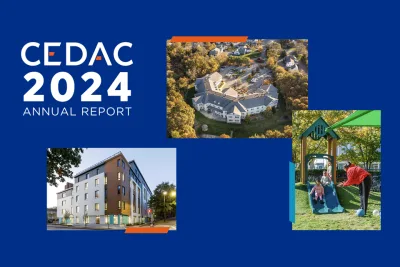Today, we hear from Mike Lindstrom – Principal of studioMLA Architects and Children’s Investment Fund (CIF) Board Chair – and Bree Horwitz, CIF Senior Project Manager, as they highlight the Horizons for Homeless Children’s new Edgerley Family Horizons Center in Boston’s Roxbury neighborhood. Mike explains how studioMLA approached the design of this child care facility.
1. How is Horizons for Homeless Children unique in its approach to childcare?
Mike: Horizons for Homeless Children (“Horizons”) primarily serves children of families experiencing homelessness, so the center was designed to reflect a trauma-informed approach. Trauma-informed care is defined as utilizing practices that promote a culture of safety, empowerment, and healing. Trauma-informed care recognizes and responds to the signs, symptoms, and risks of trauma to better support the health needs of individuals who have experienced adverse childhood experiences and toxic stress. For the families that Horizons serves, these practices are especially important.
The facility had to support spaces where children could receive various therapies and early intervention services and feel comfortable in the classroom and playground settings.
Horizons serves a vulnerable population and works with a community of single parents and other families with precarious economic and housing situations. They focus on the whole family, not just the children, by partnering parents with specially trained family advocates and additional social supports.
Bree: Horizons set out to design a new facility to consolidate its three separate existing centers, which allowed for increased child care enrollment. This also streamlined their operations and centralized care for the families and children that use this center. A wide variety of enhancement spaces such as a library and STEM lab support developmentally appropriate activities unavailable in their old facilities. This new facility also gives Horizons a permanent home after leasing their prior three spaces.
Other spaces in the building house non-profit and governmental partners, whose services will be helpful to Horizons’ families.
2. How did studioMLA approach the design of the space to address the unique needs of this program and Horizons’ staff?
Mike: Many centers for low-income children in Boston and elsewhere don’t meet childcare facilities’ basic design standards. StudioMLA worked with Horizons and CIF to ensure that best practices were incorporated into the center, from adequate square footage per child to natural light, proper ventilation, and good outdoor space. Horizons and studioMLA were very conscious of including educators, staff, therapists, and the center’s administration team in the design process, as their insights about working with this population were invaluable. We also spent time in each center to understand how they worked and how they helped or didn’t support the center’s pedagogical and therapeutic goals. Through this collaborative process, the Horizons team knew they were being heard and had a say in the design of the space. While this is a typical approach for studioMLA, Horizons was very rigorous and insistent that it happened in a thoughtful way for their staff and teachers.
Horizons needed to distinguish between child care space, meeting spaces for staff and caregivers, and administrative space. There also needed to be special meeting rooms for families and a separate, secure entrance for partner agencies in other parts of the building. We worked with Horizons to create a homey, welcoming, soft environment reflected not just in the architecture but also in the furniture and the setup.
This facility was consciously designed by studioMLA to create a connection between the administrative staff spaces and the child care center. This allowed Horizons to provide shared staff wellness and support spaces. The three existing centers were all relatively old, and the morale boost from staff, parents, and children after moving into the new space was terrific.
Bree: As an organization, Horizons has a history of managing successful capital campaigns and creating innovative spaces for their childcare programs. Their President and CEO, Kate Barrand, has a background in the corporate world and a leadership style that emphasizes buy-in from many different stakeholders in the organization. The lead executives of childcare provider agencies often don’t have the financial and personnel resources to start planning a significant capital development project as ambitious as Horizons’. With this project, Horizons has 45,000 square feet of interior space, in addition to 13,000 square feet in cantilevered outdoor balcony playspaces, which provide a safe and protected space for children to explore outdoor learning in the heart of an urban neighborhood.
Kate and her team attended the Children’s Investment Fund’s (CIF) Building Stronger Centers training, which empowers providers to plan and complete large-scale facilities improvement projects by connecting them with development professionals and extensive technical assistance and other supports. Horizons used these lessons to engage input from stakeholders, including families and staff, and sought to create a space that supported the organization’s innovative work. Kate was very invested in the evolution of the design throughout the process.
CIF provided a predevelopment loan and planning grant to help Horizons fund the early development expenses, including retaining a team of financial advisors to design the complex financing structure, which utilized New Markets Tax Credits and a capital campaign, and consultants to provide geotechnical engineering, architectural and engineering services, and construction project planning services.
Horizons also received a $1,000,000 Early Education and Out of School Time (EEOST) Capital Grant in FY19, which CIF administers on behalf of the Massachusetts Department of Early Education and Care. CIF provided the Horizons team with technical assistance and support throughout the entire development process.
3. How did studioMLA address a busy urban environment with no ground floor access to outdoor play space?
Mike: Horizons looked at many sites in Boston and evaluated each one according to the multi-dimensional criteria we helped them develop. The Roxbury site they selected is adjacent to their current headquarters and was partially owned and controlled by their current landlord, with whom they decided to partner in a joint venture. This arrangement afforded them the economies of scale of a larger project.
There was a strong demand for parking since Horizons has staff and clients from all over the state, and the joint venture developer partner wanted to assign spaces to his tenants. Neighbors expressed concern about traffic and pushed for more parking. However, the City of Boston has encouraged less parking from an environmental standpoint, and this site is only two blocks from the MBTA Orange Line station. The challenges of incorporating underground parking necessitated a design that raised the ground floor seven feet above grade of the street.
The classrooms that face Columbus Avenue look out onto trees and landscape instead of the busy street. Every classroom has natural light, and this design maximized the number of classrooms with direct access outside. This, in turn, led to more outdoor place space than we could’ve had otherwise. The new space has a beautiful, two-level natural playground with a slide and a climbing wall.
4. What challenges did studioMLA encounter with this project? What were the design team’s greatest successes?
Mike: The interior of this building was already under construction when the COVID-19 pandemic hit.
The team took a week-long pause to consider what we needed to support both short- and long-term COVID-time operations. The community space at the entry of the center was converted into a temporary intake area where families could have their temperature taken and fill out health questionnaires. Horizons adjusted the classroom capacities and group sizes to ensure social distancing. The team also added items like hand sanitizing stations and plexiglass shields around the center. With these measures in place, Horizons was able to quickly adapt to provide families with these essential front-line services. The second set of changes we implemented were more permanent and included enhanced air filtration and purification at the building systems level. What we knew as best practices before the pandemic – ample space, good light, and bathrooms in classrooms – all made it easier to operate during the pandemic.
Designing the whole building to function well and integrate the child care center, play spaces, and Horizons headquarters was a big challenge that turned into a tremendous opportunity to create a welcoming environment for the community. We had a great collaboration with a group of students from the NY School of Interior Design, who helped us select culturally appropriate and engaging colors, patterns, and fabrics. This collaboration which included the Horizon’s team enabled us to achieve Kate Barrand’s explicit goals of not having a “soulless” center.
Bree: This site would have been incredibly challenging for a first-time development team to tackle, as it previously housed automotive body shops and had a great deal of environmental contamination to address. Their team had to excavate almost an entire city block’s worth of soil and dispose of it offsite. The design maximizes the use of the parcel by integrating seven stories of commercial tenants, and could not have occurred without the expertise of the development team members and financial offset from a large number of commercial tenants on the floors above.
5. Anything else you’d like to add?
Bree: Horizons is very focused on investing in the families and children they serve, as well as their employees. The completed project is beautiful and provides a safe, welcoming, and creative space for Horizons’ youngest clients.
Mike: This was an incredibly rewarding project for studioMLA to take on, and we are proud to support the amazing work that Horizons is doing. This collaborative design process shows that if you work a little harder on making a high-quality space, it will be worth the effort.
Photos courtesy of studioMLA.








